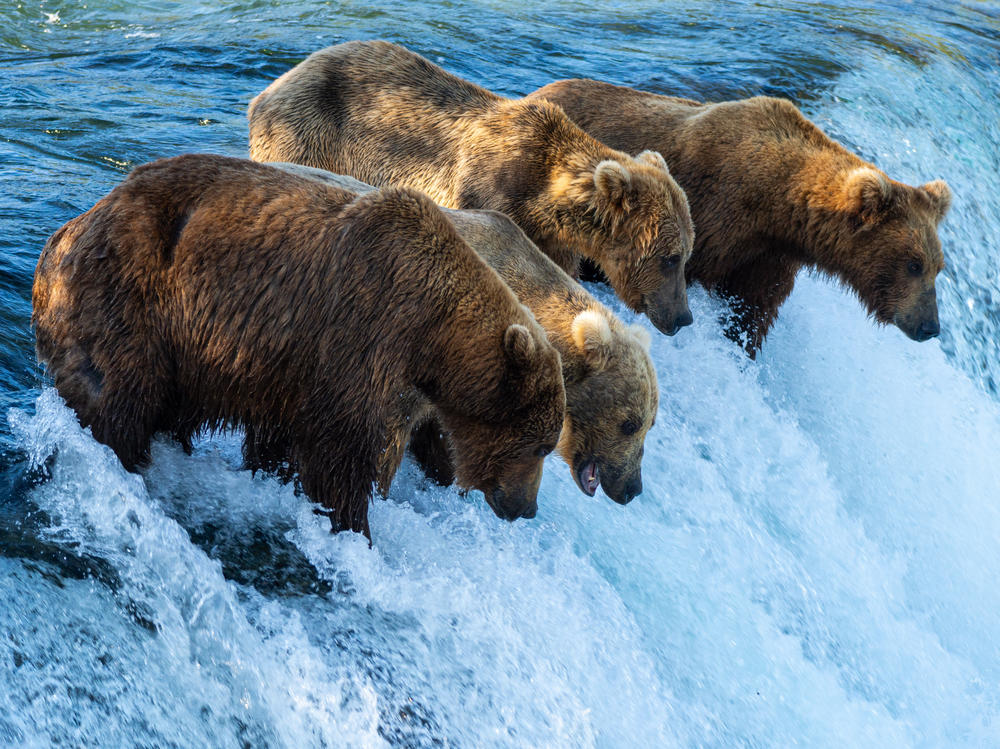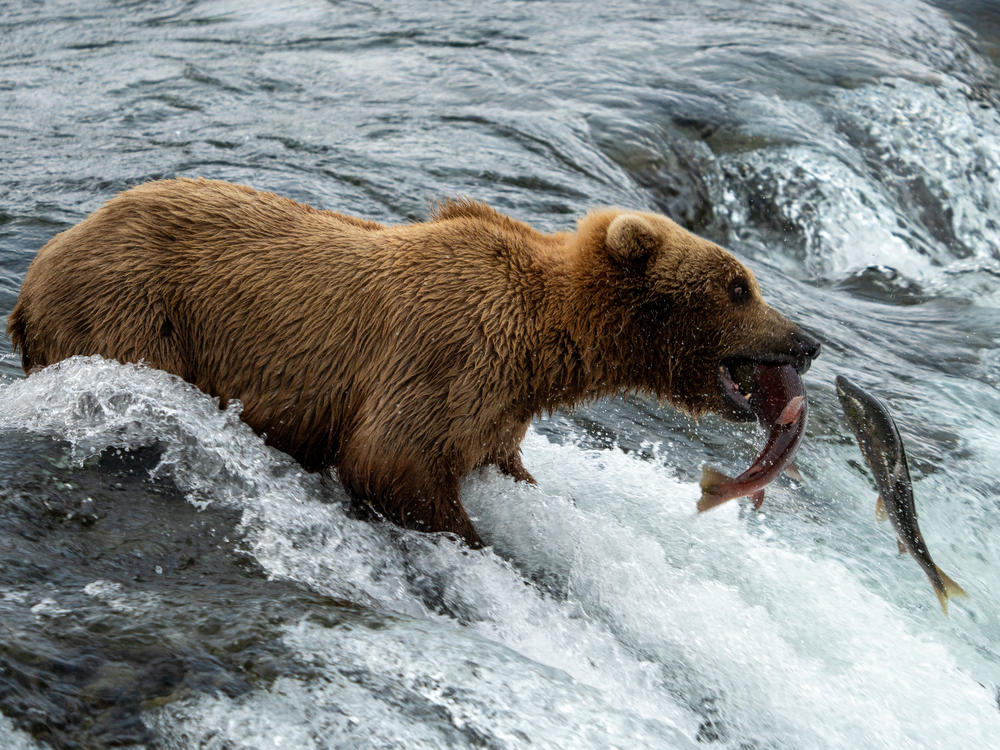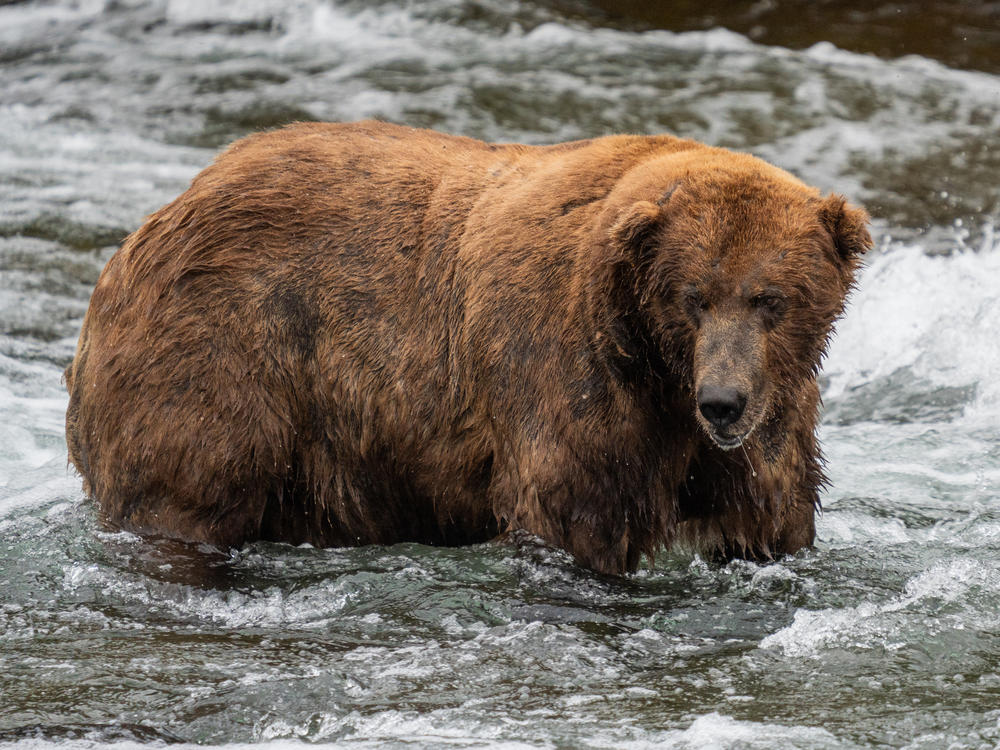Section Branding
Header Content
From hangry to chonky: Fat Bear Week is coming
Primary Content
If you've ever felt hangry, consider this: Brown bears in Alaska woke up this spring after not eating for about 6 months. And no, "hangry" might not be a technical term. But in this case, it's apt.
"That's the term I use," media ranger Naomi Boak of Katmai National Park and Preserve told NPR, speaking from Alaska.
But ever since the sockeye salmon run began on the Brooks River this summer, the bears have been feasting — and ballooning in size. That means it's time for Fat Bear Week, when fans of famous behemoths like Otis, Holly and 747 will vote for the plumpest bear in the land.
This year's competition runs from Oct. 4 through Oct. 10. Here's a quick guide:
Which bears should people keep an eye out for?
Giants like 747 — whose name evokes the jumbo jet — and 480 Otis, a multiple Fat Bear Week champion, always impress. This year's bear bracket also offers bios, with details about the large animals' equally large personalities.
Two sisters and mothers, Bears 910 and 909, could make a big splash, Boak says. In a striking development, 910 is taking care of both bears' cubs, after adopting her sister's offspring, 909 Jr.
Then there's bear 164, whom the park rangers deem one of the most innovative bears. His fans know him as "Bucky Dent," because of his unique forehead.
"He is fishing where no other bear has dared to fish: right under the lip of the falls in front of what we call 'the jacuzzi,' which is where the most dominant bears like to fish," Boak said.
"He has grown enormously in the last year," she said, "so I'd be on the lookout for him."
The 2023 bear brackets and head-to-head matchups will announced during a live chat on Oct. 2.
Just how heavy do these bears get?
"As heavy as possible," Boak said.
"We have some of the largest bears on the planet," she added. "The big boars, the biggest guys, can get to be between 1,000 and 1,400 pounds."
Sows, or female bears can reach 700 or 800 pounds, she said. For the bears to enter hibernation safely, Boak said, "they need every ounce of fat they can get."
How much salmon do the bears eat?
The known record is "42 salmon in 5 1/2 hours," Boak said, and it was set by 480 Otis, one of the river's oldest and most well-known bears.
With a limited timeframe, the bears pack on weight quickly — and when they're young, it's even more dramatic.
"Cubs are born at 1 pound and at the end of their first year, they could be 70 pounds," Boak said. "And in their second year they can end the season at 200 pounds."
How can I watch the bears?
Through the summer and early fall, fans can follow their favorite bears on webcams in the park, watching as they try to pull sockeye salmon from rapids and waterfalls along the Brooks River.
The Brooks River bears attract around 10 million virtual visitors to Explore.org's bear cams each year. Last year, more than 1 million people voted for their favorite fat bear.
People watch from their homes, offices and schools.
"We really love that children and teachers follow the bears," Boak said. There's even a Google form to let students ask questions.
"You can follow the bears for years and really get to know their lives and their personalities and their soap operas," Boak said.
Why have Fat Bear Week?
The contest is fun — but it's also a way to learn more about bears' life cycles, and to celebrate the healthy ecosystem at Brooks River and Katmai.
"The Bristol Bay ecosystem and watershed is really one of the last remaining healthy sockeye salmon runs in the world," Boak said, "and it's just gotten healthier and healthier."
The thriving ecosystem has helped bears reach maturity earlier. And this season has seen something of a baby boom.
"We had 36 cubs arrive here this year," Boak said. For context, she said that in a normal season, the area would likely see a total of around 100 bears.
How old are the bears?
Fat Bear Week contestants encompass a wide range.
"We don't discriminate by age," Boak said, noting that if a bear is living independent of its mother, it can be in the contest.
For the younger bears, a Fat Bear Junior contest precedes Fat Bear Week, giving cubs a chance to strut their stuff.
Among the adult bears, there's Sara, who is in her early 30s. Otis is in his late 20s — possibly 28 or 29, Boak said.
What happened in last year's Fat Bear Week?
The enormous 747 prevailed, turning back a challenge from the female 901 — a young upstart whom the park described as "both exploratory and occasionally mischievous."
Fat Bear contestants are, of course, blissfully oblivious to the millions of people who watch and support them.
But it seems that the competition isn't immune to our times: A key semifinal vote was recalibrated last fall, after organizers uncovered "spam votes" that were meant to send the blond-eared Holly sailing past 747 into the final.
Is winter really coming?
The autumnal equinox (on Sept. 22 or Sept. 23 in the U.S., depending on your time zone) signals shorter days and the looming winter. Fat Bear Week normally starts a week or two later.
"We don't know exactly what triggers the bears for hibernation," Boak said.
Not all bears follow the same schedule. On the Brooks River, most of the bears go into hibernation in late October or early November. They emerge again in March or April, skinny and, yes, hangry.
Copyright 2023 NPR. To see more, visit https://www.npr.org.




